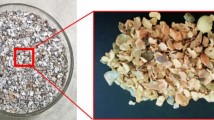Abstract
In nuclear waste repository the zone of disturbed rock adjacent to the deposition holes is a potential pathway for the transport of corrosives and radionuclides. Quantitative autoradiography using the [1 4C]polymethyl methacrylate (PMMA) method is a versatile tool for studying the rock matrix structures of centimetric and submillimetric scales. Centimetric-scale rock cores are impregnated with 1 4C-labeled methyl methacrylate ([1 4C]MMA), wetting the silicate surfaces, in a vacuum, which is followed by radiationinduced polymerization and analysis using autoradiography and optical densitometry with digital image processing techniques. The method furnishes unique information on the accessible pore space in crystalline rock. By this method was studied the damage caused by blasting in üAspüo diorite rock samples. The program Mankeli, which was implemented using Matlab Image Processing Toolbox, was used for quantitative porosity measurements. Scanning electron microscopy (SEM) and energy dispersive X-ray analysis (EDS) were used for more detailed studies. The thickness of the excavation damage zone was close to 30 mm in the studied rock samples. Electron microscopic studies revealed intra- and intergranural fissures transsecting mafic, quartz, and feldspar minerals in the crushed zone.
Similar content being viewed by others
REFERENCES
Autio, J., Aikas, K., and Kirkkomaki, T., Coring and Description of the Samples from Full Scale Experimental Deposition Holes and from the Walls of the Research Tunnel at Olkiluoto, SKB Progress Report, 1996, no. HRL-97-11.
Autio, J., Malmlund, H., Kemppainen, M., et al., Study of Rock Damage Caused by Drill and Blast Excavation as Äspö Hard Rock Laboratory, SKB Progress Report, 2001 (in press).
Siitari-Kauppi, M. and Autio, J., Investigation of Rock Porosity and Microfracturing with 14C-PMMA Method, the Blast Samples from the Walls of the Research Tunnel at Olkiluoto, Posiva Working Report, 1997, no. 97-53f.
Hellmuth, K.-H., Lukkarinen, S., and Siitari-Kauppi, M., Isot. Environ. Health Sci., 1994, vol. 30, pp. 47-60.
Siitari-Kauppi, M., Flitsiyan, E.S., Klobes, P., et al., Scientific Basis for Nuclear Waste Management XXI, McKinley, I.G. and McCombie, C., Eds., Mat. Res. Soc. Symp. Proc., 1998, vol. 506, pp. 671-678.
Author information
Authors and Affiliations
Rights and permissions
About this article
Cite this article
Kemppainen, M., Siitari-Kauppi, M., Oila, E. et al. Rock Matrix Studies with [14C]Polymethyl Methacrylate Method. Radiochemistry 43, 471–474 (2001). https://doi.org/10.1023/A:1013017222892
Issue Date:
DOI: https://doi.org/10.1023/A:1013017222892




